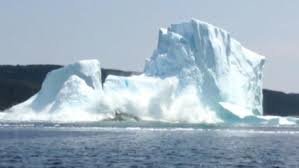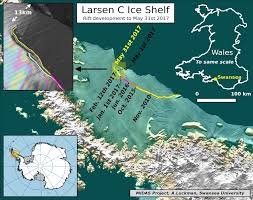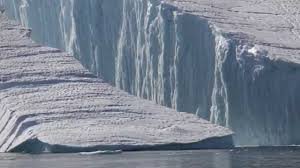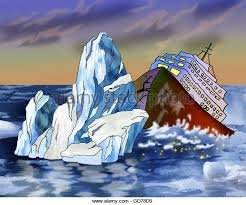Just heard the news that an Iceberg the size of a country, about 5800 sq kms, almost the size of US state of Delaware just sheared off from the Larsen C ice shelf in Antarctica. The breakaway iceberg is said to weigh over a trillion tonnes and is one of the largest on record to have shelved off from Antarctica.
The geographic and environmental impact of this incident is huge and irreversible. Apart from changing the landscape of Antarctica forever, this also contributes to a very modest change in sea level eventually.
So, what’s happening to our earth? Is this a manmade disaster (if we choose to call it so) or a natural progression of social evolution of mankind resulting from increased green house effects, the millions of tons of emissions, leading to this occurrence?
How are these icebergs connected to mankind’s evolution and progress? Do they in any manner matter to us at all? Or it is just to be neglected and forgotten as the incidences that happen in nature now and then? We have other such instances of nature’s show such as a volcanic eruption or a tectonic shift in the earth’s crust resulting in a Tsunami?
Let’s check it out. Antarctica and the North Atlantic which are one of the coldest places on earth are home to most of the icebergs. Antarctica is a huge icy southern most continent on earth which is virtually uninhabited, mass of ice. It is huge almost 2 times the size of Australia with a size of over 5.4 million square miles. So when a chunk of ice calves or breaks off from the shelf and starts floating as a land / ice mass of its own, an iceberg is born.
Well these icebergs are pieces of ice formed that float on water (say an ocean or a lake). Any piece of floating ice larger than 5 metres across qualifies itself as an iceberg and now we are speaking of a 5400 sq kms floating mass of ice that just broke off from the Larsen-C ice shelf just a while back. Phew!!!! That is huge. Just huge! Now what is an ice shelf? Well ice shelf is a floating expansion of a land ice mass.
Now these floating mass of ice, the icebergs float and reaches the warm waters, the ocean, and begins to melt due to the warmer climate. This warm water further breaks up the iceberg as they melt the icebergs forming ice pools known as melt ponds and eventually breaking chunks off the iceberg.
Icebergs are important as they can alter the climates, change the ocean processes. Icebergs are made of fresh water. So with iceberg melting, the influx of fresh water into the ocean influences their currents and circulation. These icebergs are rich with nutrients and contribute to increase in plankton, fish and marine life in general.
But on the flip side, the melting iceberg contributes to increase in the sea water level which does bode well to many of our coastal cities. These floating icebergs are also a real danger to ocean going vessels as these are large enough to sink a ship, should they collide with one.
After the historic sinking of Titanic, a few countries including United States formed a consortium to warn the ships of the danger of floating icebergs. This consortium known as International Ice patrol uses airplane and radars to monitor the oceans where the icebergs are likely to be found (the Antarctica and North Atlantic) and warn the ships in the region with their precise location. But the danger of a ship colliding with an iceberg is very real as some of smaller / tiny pieces of icebergs known as bergy bits or growlers are difficult to be spotted by ships. So having an eye in the sky helps to avert any danger to the vessel.
The importance of this incident can be understood by the fact that 12% of Larsen C ice shelf contributes to this particular iceberg size and this single occurrence can contribute to increase the global sea mark by around 1 cm.
Ice shelves break up naturally, however The rising global temperatures due to greenhouse affects are contributing massively to the breaking of the icebergs from their ice shelves at an accelerated pace. The temperature are already well over the agreed level ( the 2015 Paris agreement which calls to cap the warming / increase in temperature under 2 deg over the pre-industrial period temperature.i.e. about 250 years ago.). With passage of time, with technology and science making rapid pace in all spheres in life, the warming up of the earth has also gathered pace and our earth is already 1.1 degree hotter than it was a couple of hundred years ago. This might seem very insignificant rise, but again human life can survive only a very narrow band of temperature rise on earth.
This breaking of the massive iceberg is as spectacular to the science world, the environmentalist, the researchers and sundry, but also a dire warning to the mankind that we are contributing to irreversible damage to the nature and accelerating to a stage which may not be conducive for life for our future generations here.
Credit: All Images sourced from internet.
Material Reference: Here



